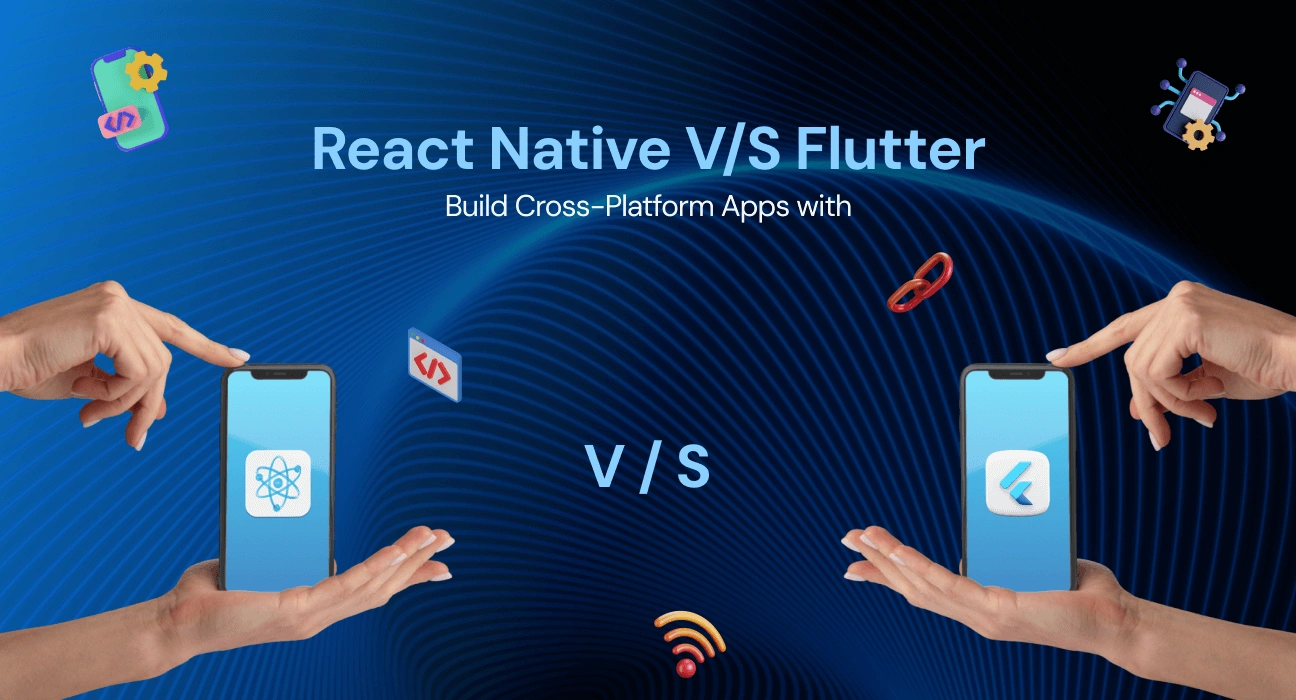

Cross-platform development is increasingly seen as the best way to deliver new mobile applications. It allows you to reach users, on both iOS and Android, with just one codebase.
As of 2025, almost 46% of app developers worldwide are using Flutter for app development, while React Native powers major apps like Facebook, Instagram, and Airbnb.
This platform-based approach is popular because of the lower average development costs. In fact, around 50 to 75% of the costs are associated with developing 2 separate app versions. Both startups and established enterprises use custom mobile app development solutions to grow their reach and save money.
This is especially true when leveraging services from a custom software development service provider that specialize in advanced frameworks. Here, we are going to discuss every aspect related to cross-platform mobile development in detail to help you move ahead with clarity.
What is Cross-Platform Development?
Cross-platform development fundamentally refers to developing mobile apps to run on different OS platforms, typically iOS and Android, using the same source code. It is estimated that most of the new mobile apps are built using cross-platform frameworks reflecting a need for rapid development and consistent experiences for users.
There continues to be a great deal of momentum in the marketplace for mobile app development platforms. The reason behind it is that organizations no longer want custom software development services that cannot adapt quickly to changing technical specifications, feature integrations, and user growth. So, below we highlight different attributes in detail to help you get the right framework in use.
The Rise of Cross-Platform Development Frameworks
By 2025, a sizable segment of business-critical apps are built using cross-platform frameworks. Some recent statistics from industry-wide surveys:
- Flutter is being used by 46% of developers around the world, from start-ups to Fortune 500.
- React Native drives popular applications like Facebook, Instagram, Airbnb, and Bloomberg.
- Kotlin Multiplatform is growing for Android-centric and multiplatform applications.
Also Read: Top Android App Development Frameworks
Flutter Development Services: Why Choose Flutter?
Flutter is Google’s open-source framework to build natively compiled applications for mobile (iOS, Android), web and desktop, with a single code base using the Dart programming language. Reasons for popularity:
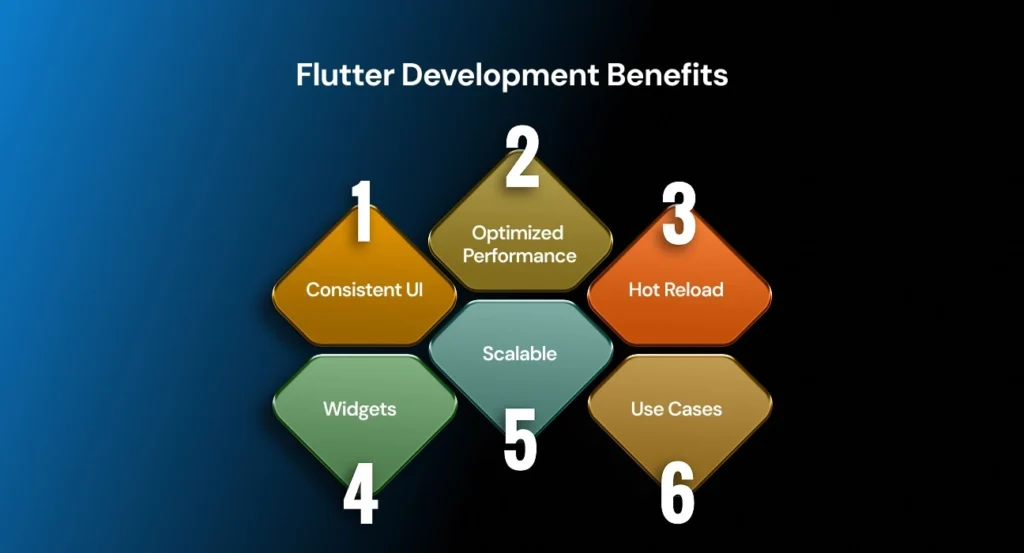
- Consistent UI – Flutter provides its own rendering engine and every component, whether it be UI or UX, will look and act the same across some of their platforms regardless of the evolution of native OS components.
- Optimized Performance – Flutter, similar to React Native, has low-overhead tools to give high-fidelity, GPU-Optimized rendering with rich animations to compete with native Apps, and leverage Apple’s (2022) Impeller engine.
- Hot Reload – Developers can view changes instantly while modifying code for rapid iterations, and quickly spot a bug if necessary.
- Widgets – Flutter uses Material Design (Android) or Cupertino (iOS) widgets that provide great out-of-the-box customization options.
- Scalable – Scalable for growing apps with complex UIs and wait-times .
- Use Cases – Applications with custom UI and fast performance; finance (Nubank), e-commerce, learning, publications and entertainment.
React Native Development Services: Why Choose React Native?
React Native, an open-source project developed by Meta (Facebook) for cross-platform app development, allows rapid development of cross-platform applications utilizing JavaScript and React. The strengths of React Native are:
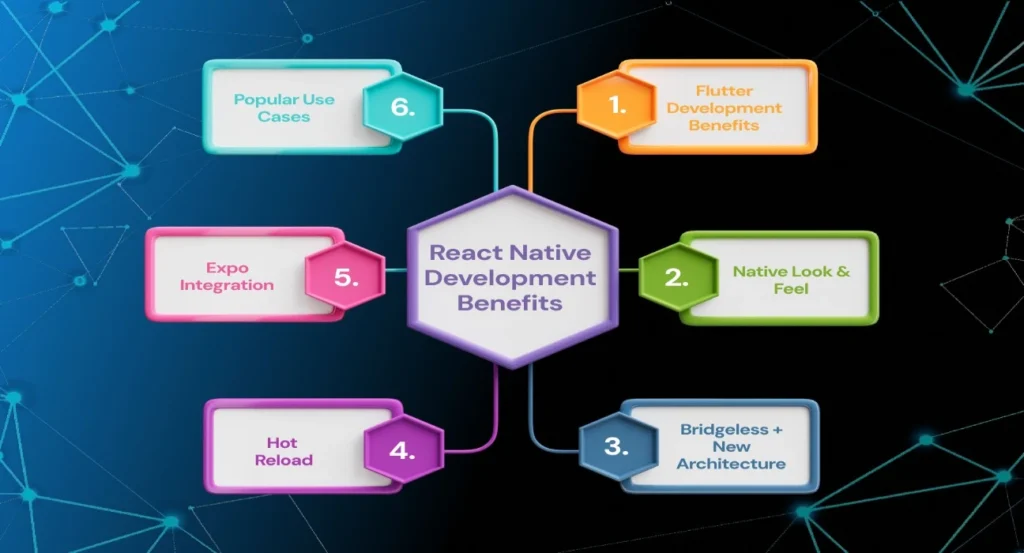
- Native Look & Feel: Builds native user interface components on each platform providing a real native feel and leveraging platform first functionality.
- Large Ecosystem: React Native development services utilizing the framework can quickly solve engineering problems due to the thousands of plugins and third-party tools that are available, plus the strong community support.
- Bridgeless + New Architecture: One advantage of React Native, as of 2025, is that it will have an architecture that will utilize no bridges and collection of new features called JSI and TurboModules, which means faster user interface responsiveness, smaller app footprint, and improved startup times.
- Hot Reload: Code changes can be made in real-time with hot reload actively servicing the same instance of the app for quick debugging.
- Expo Integration: React Native offers the opportunity to integrate with the Expo platform, which offers single click deployments, CI/CD options, cross platform compatibility, Over-the-Air updates and the ability to develop the architecture to scale rapidly.
- Popular Use Cases: Apps that will be consistently updated, apps that will have the current stack of functionality being seamlessly integrated, and apps that can utilize the high availability of JavaScript developers.
Flutter vs Kotlin vs React Native: Feature Comparison
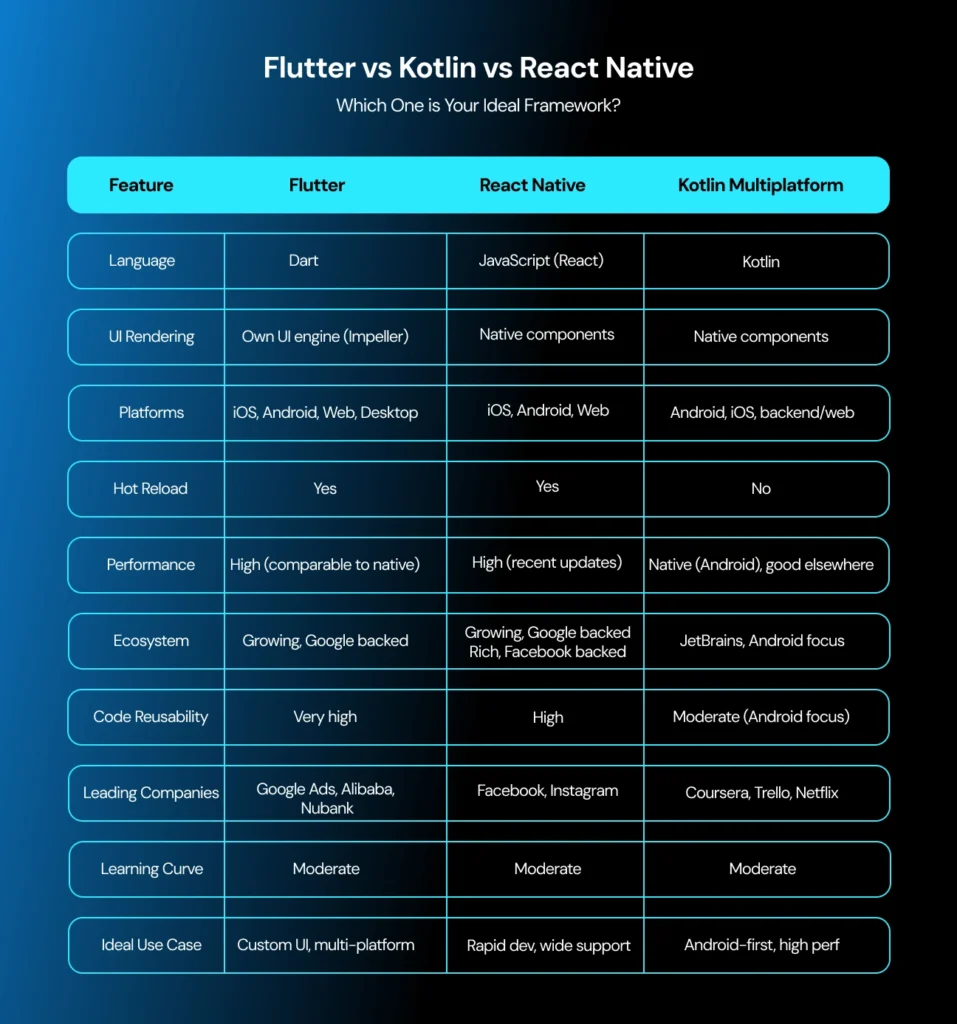
Cost to Develop: What Influences the Price?
The cost to develop in 2025 can differ widely based on the complexity of the app, the features needed, and the platform used.
Here are the most recent statistics:
- Basic Cross Platform App: $20K – $30K
- Moderate Complexity App: $35K – $65K
- Advanced/Enterprise App: $70K – $150K+
Factors that can rise or lower your expenses:
- Complexity of app (e-commerce, real-time chat, AR/ML)
- Number of platforms (mobile, web, desktop)
- How much design and UI customization is required
- Integrating app with cloud services (e.g. Firebase, AWS)
- Yearly ongoing maintenance costs (25% of overall costs+)
- Location and expertise of team
Savings tip: Cross-platform apps save roughly 50 – 75% compared to building an iOS app and a separate Android app (native).
Choosing a Custom Software Development Company
The choice of a custom software development company can make or break your project.
1. Expertise with Cross-platform App Development
Choose a firm that has developed multiple apps using multiple frameworks, and that documents those projects with case studies and/or portfolios that represent complex and high-performance apps. That will give you an assurance they know the pros, cons, and technical aspects of each platform. Most importantly, they can identify when one isn’t a good fit and why in relation to your business’s needs
2. Providing Customized Mobile App Development Solutions
Industry experience means the team will have an understanding of your market’s compliance standards, user behavioral expectations, and levels of competition. Also, an established partner can offer insights about new trends or features that work well for your target audience.
3. Solid Post-Launch Service
By offering post-deployment services, your partner can ensure your app keeps on working, is secure, and is continuously updated according to operating systems’ and devices’ changes. Ongoing surveillance and enhancement services ensure that your app guarantees optimum performance, security, and user touch over time.
Current Trends for Cross-Platform App Development
In 2025, the cross-platform app development landscape is shaped by a number of emerging technology trends, all of which are changing and driving how developers create software and drive delivery. AI-augmented coding programs like GitHub Copilot and Amazon CodeWhisperer help accelerate development through the automation of code snippets, the identification of bugs, and rapid integration, all of which can increase productivity and reduce mistakes.
Performance optimization is still top of mind with frameworks advancing memory management, load times, and power and battery consumption, all of which aims to provide a better user experience. Accessibility has been improved through WCAG 2.2 updates, as well as better screen-reader support, and we better leverage semantic role definition by specification, to allow apps to be more inclusive in general use.
Cloud integration with companies like Firebase, AWS Amplify, Supabase, and Azure means backend is connected seamlessly. Security and compliance features are supporting frameworks out-of-the-box with GDPR, HIPAA, and other regulations from day one, securing end-user data and complying with legislation. In combination of these trends, businesses are now able to build faster, scalable, and secure cross-platform apps.
Flutter vs React Native: Which One to Choose?
Your ideal framework depends on:
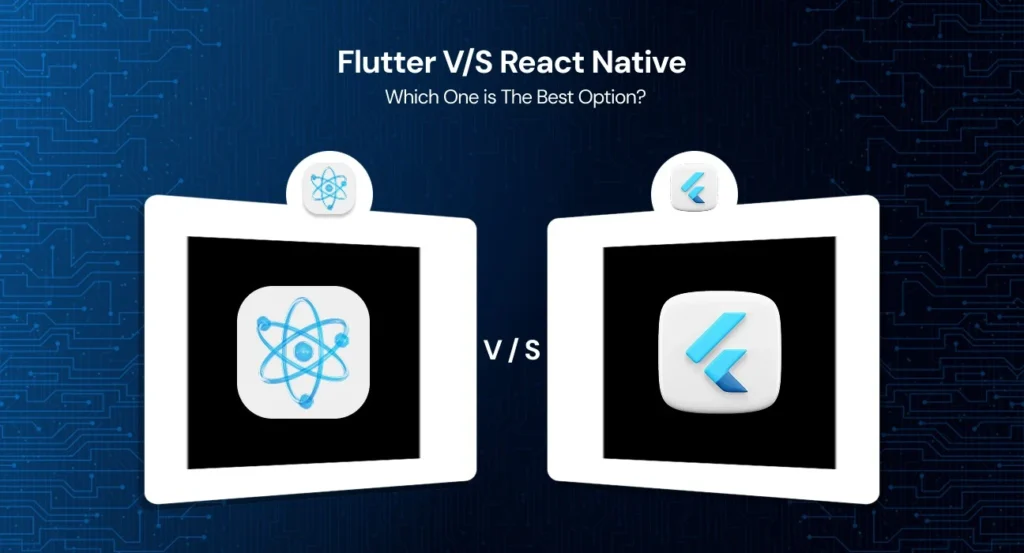
1. Project Complexity
If your project values highly developed user interfaces, the unified and seamless user experience with rich animations, your best solution is Flutter. Flutter is a framework with a rendering engine and great widget customization that really gives the best solution for apps bound by UI/UX like finance systems, e-commerce, or entertainment. It can also be used for commercial apps when UX is the priority. React Native is great when the speed of prototyping and fast programming cycles give you a competitive advantage, and your team already has familiarity with, and are using JavaScript as often as possible in versioning products (iterative product development). Whenever an Android project requires an app with deep integration into hardware or APIs, Kotlin is the best choice and will always generate the best performance and reliability for high performing enterprise apps.
2. Target Platforms
Whenever you are targeting more than one platform (seeking only web or desktop apps) and wish the same codebase can be maintained for iOS, Android, web, and desktop apps, Flutter is the best choice to handle your environmental issues quickly without losing any functionality. Being able to keep updated and consistent across devices is a major strength of Flutter. React Native is great when your first priority is the best mobile platforms focused on iOS + Android and you want to make a slightly less rigid commitment to web and desktop development disadvantages. Kotlin is the winner when the scenario is pure Android, but Kotlin’s multiplatform support is growing significantly, specifically for backend and web parts—making it an excellent choice for projects with Android at their core and the need for backend extensibility in the future.
3. Team Skills
For teams who are experienced in JavaScript and React, React Native is a syntactically similar environment that utilizes vast libraries and resources, which means a decreased onboarding curve. Dart and object-oriented developers love Flutter, given that it has an easy syntax, considerable documentation, and a fast workflow of hot reload, collaboration, and innovation in a productive manner. Native Android developer teams, who are well-versed in Java or Kotlin, will likely prefer Kotlin, owing to the modern language features, open interoperation with Java, and its potential for maintainability, important for long-run success in Android app development and long-term projects involving legacy codes.
Future Outlook
Cross-platform development frameworks will increasingly dominate mobile-app creators’ platform needs as they provide richer functionality and capabilities, lower costs, and speedier time to market for custom mobile app development solutions. As enterprise needs shift, from mobile back to desktop, web, and even wearables, etc., the selection of frameworks can make or break user experience, performance, and long-term scalability.
Final Thoughts
Regardless of whether you choose Flutter development services, React Native development, or deep integration with Kotlin Multiplatform, working with a custom software development service provider specializing in cross-platform development is the best way to ensure that you will have scalable and cost-effective mobile solutions for your business going forward. You can always consider connecting with the experts at LL TechnoLab for complete assistance on cross-platform app development.
